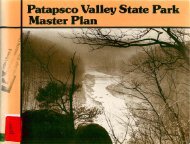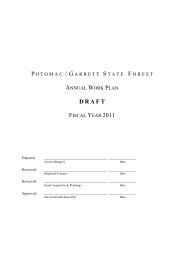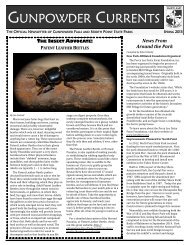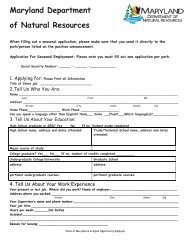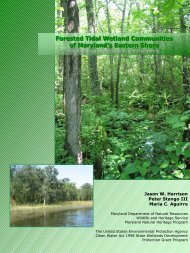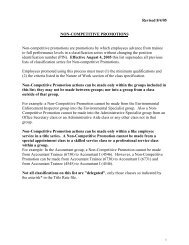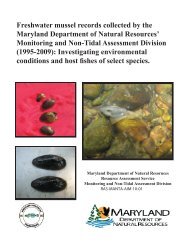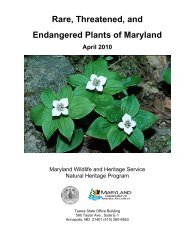What is Freeboard? - Maryland Department of Natural Resources
What is Freeboard? - Maryland Department of Natural Resources
What is Freeboard? - Maryland Department of Natural Resources
You also want an ePaper? Increase the reach of your titles
YUMPU automatically turns print PDFs into web optimized ePapers that Google loves.
<strong>What</strong> <strong>is</strong> <strong>Freeboard</strong>?<br />
Ra<strong>is</strong>e Your Home, Lower Your Payments<br />
<strong>What</strong> <strong>is</strong> <strong>Freeboard</strong>?<br />
<strong>Freeboard</strong> <strong>is</strong> elevating a building’s lowest floor<br />
above predicted flood elevations by a small<br />
additional height (generally 1-3 feet above<br />
National Flood Insurance Program [NFIP]<br />
minimum height requirements). Elevating<br />
a home a few feet above legally mandated<br />
heights has very little effect on its overall<br />
look, yet it can lead to substantial reductions<br />
in flood insurance, significantly decrease the<br />
chances the home will be damaged by storms<br />
and flooding, and help protect it against the<br />
impacts <strong>of</strong> sea level r<strong>is</strong>e.<br />
<strong>What</strong> Are the Benefits <strong>of</strong> <strong>Freeboard</strong>?<br />
Increased protection from floods and storms.<br />
Storm waters can and do r<strong>is</strong>e higher than<br />
shown on Flood Insurance Rate Maps (FIRMs).<br />
<strong>Freeboard</strong> helps protect buildings from storms<br />
larger than those that FIRMs are based on, and<br />
provides an added margin <strong>of</strong> safety to address<br />
the flood modeling and mapping uncertainties<br />
associated with FIRMs.<br />
Examples <strong>of</strong> savings on NFIP1 with freeboard<br />
Zone V 2<br />
Without <strong>Freeboard</strong> With 2’ <strong>of</strong> <strong>Freeboard</strong><br />
Annual flood insurance: $7,750 Annual flood insurance: $3,440<br />
Annual savings in Savings over<br />
NFIP premiums 30-year mortgage<br />
1’ freeboard $2,565 (33%) $76,950<br />
2’ freeboard $4,310 (56%) $129,300<br />
3’ freeboard $5,160 (67%) $154,800<br />
Better preparation for ongoing sea level r<strong>is</strong>e.<br />
H<strong>is</strong>torically, <strong>Maryland</strong> has experienced a relative<br />
sea level r<strong>is</strong>e <strong>of</strong> approximately 1 foot over the<br />
past 100 years. In the future, however, due to the<br />
combined forces <strong>of</strong> regional land subsidence and<br />
global climate change, <strong>Maryland</strong> may experience<br />
3 - 4 feet <strong>of</strong> sea level r<strong>is</strong>e over the next century.<br />
Since elevations on FIRMs do not include sea level<br />
r<strong>is</strong>e, freeboard will help keep structures above<br />
floodwaters as storm surge elevations increase.<br />
For th<strong>is</strong> reason, the <strong>Maryland</strong> Comm<strong>is</strong>sion on<br />
Climate Change recommends 2 or more feet<br />
<strong>of</strong> freeboard for structures located in tidally<br />
influenced floodplains.<br />
Greatly reduced flood insurance premiums.<br />
Recognizing that freeboard reduces flood r<strong>is</strong>k, the<br />
Federal Emergency Management Agency (FEMA,<br />
which admin<strong>is</strong>ters the NFIP) provides substantial<br />
(sometimes more than 50 percent) reductions<br />
in flood insurance premiums for structures that<br />
incorporate freeboard. These savings can rapidly<br />
accumulate, especially over the life <strong>of</strong> a normal<br />
mortgage.<br />
$725 (46%) $21,750<br />
$984 (63%) $29,520<br />
$1,074 (68%) $32,220<br />
1 NFIP premiums based on October 2010 rates for a one-floor residential structure with no basement built after a FIRM<br />
was <strong>is</strong>sued for the community (post-FIRM rates differ from pre-FIRM rates). $500 deductible/$250,000 coverage for the<br />
building/$100,000 for contents.<br />
2 Zone V: Th<strong>is</strong> Flood Insurance Rate Map (FIRM) designation refers to coastal areas that are subject to the highest levels <strong>of</strong> wave<br />
energy and flooding.<br />
3 Zone A: Also a FIRM designation, these areas are subject to flooding but with less wave energy than Zone V (i.e., wave heights<br />
less than 3 feet).<br />
Zone A 3<br />
Annual savings in Savings over<br />
NFIP premiums 30-year mortgage<br />
Protect<br />
buildings<br />
and reduce<br />
monthly<br />
expenses<br />
with<br />
freeboard<br />
Martin O’Malley, Governor<br />
John R. Griffin, Secretary
Coastal Zone<br />
Counties:<br />
Anne Arundel<br />
Baltimore<br />
Calvert<br />
Caroline<br />
Charles<br />
Cecil<br />
Dorchester<br />
Harford<br />
Kent<br />
Prince George’s<br />
Queen Anne’s<br />
Somerset<br />
St. Mary’s<br />
Talbot<br />
Wicomico<br />
Worcester<br />
and<br />
Baltimore City<br />
Photo credits:<br />
Jack Diamond, Chuck Prahl,<br />
Laura Younger, Chr<strong>is</strong> Paul<strong>is</strong>,<br />
George Close and<br />
Andy Aughenbaugh<br />
11/2012 14-12222009-428<br />
Printed on recycled paper<br />
<strong>What</strong> Are the Costs <strong>of</strong> <strong>Freeboard</strong>?<br />
The expense <strong>of</strong> incorporating freeboard into<br />
new structures <strong>is</strong> surpr<strong>is</strong>ingly low, generally<br />
adding only about 0.25 to 1.5 percent<br />
to the total construction costs for each<br />
foot <strong>of</strong> added height, according to a 2006<br />
FEMA-comm<strong>is</strong>sioned study (Evaluation <strong>of</strong> the<br />
National Flood Insurance Program’s Building<br />
Standards). The minor resulting increase in<br />
monthly mortgage payments (<strong>of</strong>ten less<br />
than $20 a month) <strong>is</strong> generally more than<br />
<strong>of</strong>fset by savings on NFIP premiums. Consequently,<br />
adding freeboard typically saves<br />
homeowners money, sometimes over $200 a<br />
month.<br />
Who Can Benefit from <strong>Freeboard</strong>?<br />
Nearly everyone building in floodplains can<br />
better protect themselves and their property<br />
and save on flood insurance by including<br />
freeboard in their construction and reconstruction<br />
projects. Benefits include:<br />
Homeowners — Elevating your home<br />
increases the chances that it will weather<br />
storms safely and will decrease your<br />
worry and protect your investment. If<br />
you’re building a new home, or doing a<br />
renovation, ask your builder/designer about<br />
incorporating freeboard.<br />
Builders/Contractors — <strong>Freeboard</strong> provides<br />
a competitive edge over other builders,<br />
allowing you to market the benefits <strong>of</strong><br />
reduced flood insurance and flood r<strong>is</strong>k<br />
to potential buyers and clients doing<br />
renovations.<br />
Local Governments — Encourage the use <strong>of</strong><br />
freeboard in appropriate private and public<br />
construction throughout your community’s<br />
floodplain.<br />
Businesses — <strong>Freeboard</strong> helps to protect<br />
your buildings, important records, and<br />
inventory from flooding; drastically decrease<br />
your recovery/clean-up time after storm;<br />
and potentially save your business. The<br />
Insurance Institute for Business and Home<br />
Safety reports that more than 25 percent <strong>of</strong><br />
businesses that close due to storm damage<br />
never reopen.<br />
From http://www.cleanair-coolplanet.org/for_communities/adaptation_floodplain_ordinance.php.<br />
Photo by USGS<br />
Coastal Geolog<strong>is</strong>t Pete Slovinsky in December 2009.<br />
For More Information . . .<br />
• For specific information on good<br />
construction practices (including<br />
freeboard), see FEMA’s Home Builder’s Guide<br />
to Coastal Construction, http://stsm.us/md1.<br />
• For technical details on costs <strong>of</strong> using<br />
different flood-res<strong>is</strong>tant building<br />
techniques (including freeboard), see<br />
the American Institutes for Research’s<br />
Evaluation <strong>of</strong> the National Flood Insurance<br />
Program’s Building Standards at http://stsm.<br />
us/md2.<br />
• For general information on the National<br />
Flood Insurance Program, see www.<br />
FloodSmart.gov.<br />
• For specific questions on flood insurance<br />
rates, see a licensed insurance agent.<br />
• Communities looking for more information<br />
on the National Flood Insurance Program<br />
can contact the State NFIP Coordinating<br />
Office: 410-537-3775, mdfloodmaps@mde.<br />
state.md.us.<br />
• For information on how <strong>Maryland</strong><br />
communities can protect themselves from<br />
storms, see the CoastSmart website at<br />
http://dnr.maryland.gov/CoastSmart/index.<br />
asp, or contact the Chesapeake & Coastal<br />
Service at 410-260-8743 CoastSmart@dnr.<br />
state.md.us.<br />
• Businesses looking to prepare for storms<br />
and other catastrophic events should v<strong>is</strong>it<br />
the Insurance Institute for Business and<br />
Home Safety’s website at www.ibhs.org.<br />
• To read <strong>Maryland</strong>’s Climate Action Plan<br />
and learn more about how the State <strong>is</strong><br />
preparing for sea level r<strong>is</strong>e, v<strong>is</strong>it http://<br />
www.dnr.state.md.us/climatechange/.<br />
Financial ass<strong>is</strong>tance provided by the Coastal Zone Management Act <strong>of</strong> 1972, as amended, admin<strong>is</strong>tered by the Office <strong>of</strong> Ocean and Coastal Resource<br />
Management, National Oceanic and Atmospheric Admin<strong>is</strong>tration (NOAA). A publication <strong>of</strong> the <strong>Maryland</strong> Coastal Zone Management Program,<br />
<strong>Department</strong> <strong>of</strong> <strong>Natural</strong> <strong>Resources</strong> pursuant to NOAA Award No. NAO9NOS419170. Based on a fact sheet assembled by the Massachusetts Office <strong>of</strong><br />
Kate Skaggs l <strong>Maryland</strong>’s Chesapeake & Coastal Service<br />
<strong>Maryland</strong> <strong>Department</strong> <strong>of</strong> <strong>Natural</strong> <strong>Resources</strong> l Tawes State Office Building, E-2<br />
580 Taylor Avenue l Annapol<strong>is</strong>, <strong>Maryland</strong> 21401<br />
Phone: 410-260-8743 l Fax: 410-260-8739<br />
Email: kskaggs@dnr.state.md.us<br />
V<strong>is</strong>it the CoastSmart Website: www.dnr.maryland.gov/CoastSmart



